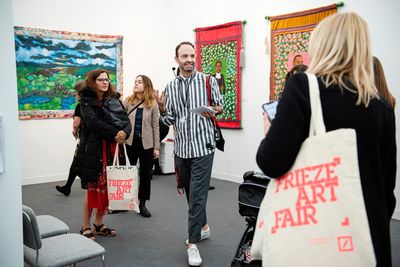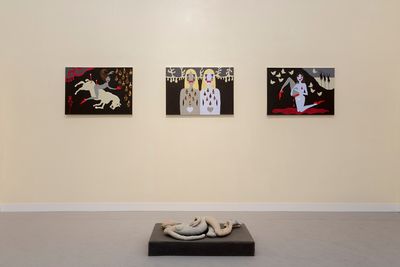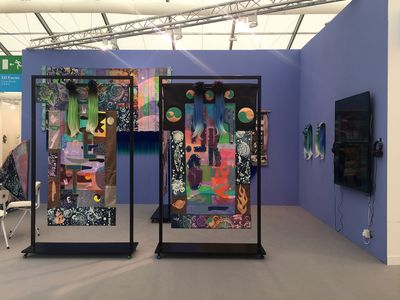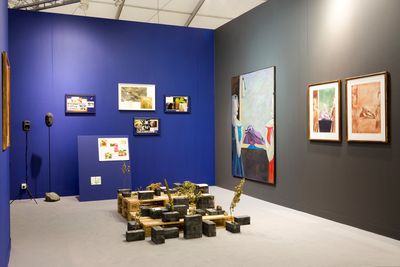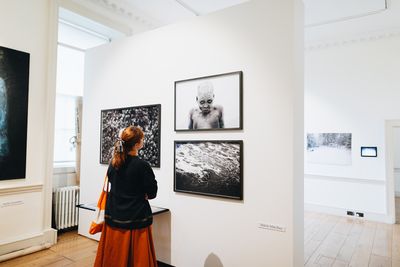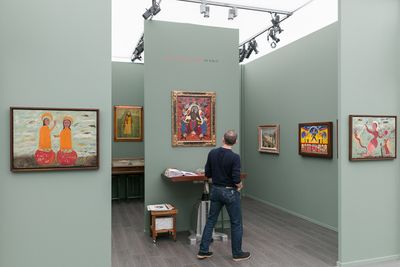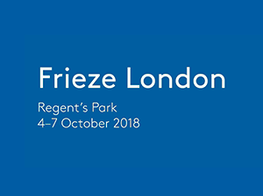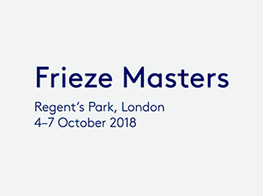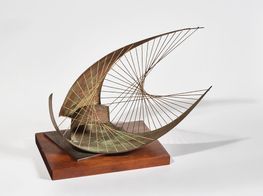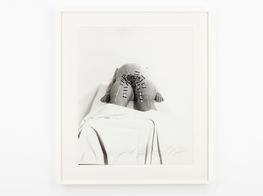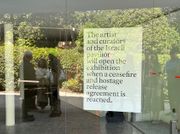Frieze Week 2018: London, Masters and 1-54 Wrap-up

Ibrahim El-Salahi, Meditation Tree (2018). Exhibition view: 1-54 Contemporary African Art Fair, Somerset House, London (4–7 October 2018). Courtesy the artist and Vigo Gallery. Photo: © Katrina Sorrentino.
A rush of politics kicked off Frieze Week this year, with a talk between Chelsea Manning and James Bridle organised by the Institute of Contemporary Arts at the Royal Institution, three days ahead of the opening of Frieze London, Frieze Masters and 1-54 (4–7 October 2018). The event felt more like a press conference, with attendees seemingly composed mostly of journalists. Holding nothing back, Manning compared the United States to a prison state, as the fallout of the vote to confirm judge Brett Kavanaugh to the Supreme Court—amidst a series of sexual assault allegations—peppered social media feeds. Manning spoke emphatically in support of direct community action and resistance in the age of Trump. The audience came to be inspired and left fired-up.
There were flickers of that fire throughout Frieze Week, with the art world showing signs of engaging with the politics of the present. At Frieze London, murmurs of a sterile atmosphere and sluggish sales were offset by a positive response to the fair's Social Work sector, which focused on the work of eight women artists whose practices emerged during the 1980s and 90s as a response to the social and political turbulence at the time, including Mary Kelly, Berni Searle, Ipek Duben and Tina Keane. The section was curated by a panel of women, including Iniva director Melanie Keen, David Roberts Art Foundation director Fatos Üstek, and Lydia Yee, chief curator at the Whitechapel Gallery.
The veteran octogenarian artist Faith Ringgold was represented in this sector by Weiss Berlin & ACA Galleries, showing a selection of 'quilt paintings' created from the 1980s up to 2017. These document heroes of black American culture, such as filmmaker and gay rights activist Marlon Riggs. Marlon Riggs: Tongues Untied (1994) features a painted portrait of Riggs in the centre of the frame, around which the quilting of various fabrics—here, floral—creates a border. The first border framing Riggs features lines of text, including a reference to a famous quote by American feminist and civil rights activist Audre Lorde, 'MASTER'S TOOLS WILL NEVER DISMANTLE MASTER'S HOUSE'.
In the Focus section, Arcadia Missa continued the theme of feminist representation, showing the 'Amelia Paintings' (2018) by Penny Goring: acrylic on canvas expressions of a dystopian world inhabited by young girls, executed in a uniform graphic style in which female figures pose against black backdrops, over which Matissean patterns suggest the forms of trees and shrubs. Union Pacific put together a fantastic stand of intricate, textile-based wall-hangings and sculptures by Zadie Xa: one-dimensional robes made of layers of fabric and plaits of brightly coloured fake hair that take inspiration from the artist's identity as a member of the Asian diaspora. The result is a thrilling mix of traditional patterning—Xa uses bleach and hand-dye techniques—and post-internet aesthetics.
The Cairo-based Gypsum Gallery also stood out in the Focus sector, with a booth that paired surreal, figurative paintings populated by stylised figures located in near-abstract spaces by Egyptian poet, writer and artist, Ahmed Morsi, with an installation by Palestinian duo Basel Abbas and Ruanne Abou-Rahme. Abbas and Abou-Rahme's project And Yet My Mask is Powerful (2016) is an assemblage of documents, images, and objects that draw on the history of some of the oldest Neolithic masks in the world, which were discovered in the West Bank and are now stored in private Israeli collections. The installation was one of the most political at the fair, and its pairing with Morsi's painting was inspired. 'Coming from completely disparate space-times,' the gallery notes, 'the artists share an urge to rebuild an image of what is no longer accessible.'
In many ways, 1-54 Contemporary African Art Fair is attempting the same kind of recuperation. Opening its sixth London edition on 4 October, there was a higher number of galleries participating this year, with 43 galleries from 21 different countries, 16 of which have a space in Africa. With over 130 artists from Africa and its diaspora represented, there was a spread of works providing a welcome insight into artistic practices from within and around the region.
Setting the scene was a specially commissioned trio of sculptures for 1-54's Special Projects programme by 88-year-old Ibrahim El-Salahi—the first artist from Africa to have a retrospective at Tate Modern. Meditation Tree (2018) consists of three Acacia trees produced in oak, which ran down the middle of the neo-classical courtyard at Somerset House. (They were specially commissioned for the fair, and reportedly sold before it even opened.)
There was a strong showing of photography throughout 1-54. Striking prints by Angolan artist Keyezua at MOVART expressed a feminist edge, with staged scenes shot against red backgrounds with subjects dressed in blue ('Floating Nightmares', 2018). In one image, we see a woman riding and gagging her male counterpart; another shows a man breastfeeding from a prostitute. Paying homage to the glamour of Egyptian cinema was Youssef Nabil's hand-coloured silver gelatin prints at Galerie Nathalie Obadia, in which figures portrayed as seductive starlets pay homage to a silver screen-era of romance, intrigue, and longing.
Other standout photographic works included incredible silver gelatin prints at Yossi Milo Gallery by Sanlé Sory, taken from the 'Volta Photo' series, which capture life in Burkino Faso between 1965 and 1985; and Mário Macilau's stylised black and white photographs of boys at the beach at Ed Cross Fine Art ('Faith', 2018). At Loft Art Gallery, Moroccan Hicham Benohoud showed conceptual landscapes and interventions that sit somewhere between photography and land art, with C-print editions showing sculptural objects and painted concrete planes positioned on a desert floor, surrounded by sand and debris.
Irish-Nigerian sculptor LR Vandy brought an entirely 21st-century approach to traditional African sculpture at The October Gallery. Vandy takes forms associated with traditional African masks, many originally used in ritual ceremonies but now often sold as wall decorations, and gives them a modern twist. Using modern materials such as fibreglass and fishing floats, wall sculptures in the shape of African ceremonial and decorative masks feature spikes attached to the surface that run around the edge.
Reflecting on the experiences of the diaspora was British-Ghanaian artist Larry Achiampong at London's Copperfield Gallery. Achiampong's film Sunday's Best (2015) deals with the artist's experience attending church as a young black man in Britain, and his encounters with representations of a white Jesus. Hanging on the walls around this video installation were archival C-type prints from the artist's 2015 'Glyth' series, for which the artist covers the faces in family photos with a generic racist gollywog-inspired blackface—black circles with pouting red lips; a motif repeated in the artist's 'Holy Cloud' series (2014), in which these faces are superimposed onto religious imagery printed onto MDF and sitting on wide church candles.
The Gallery of Everything showcased artworks by Haitian spiritualist Robert Saint-Brice, who saw his paintings—which gained recognition after he joined the Centre d'Art d'Haïti in 1949—as physical manifestations of his beliefs. His looming figures, smiling and benign, appear to melt into backgrounds composed of cross-hatching strokes of gradated colour, appearing like otherworldly spirits emerging from impressions of dense shrubbery, or darkened skies, for instance.
The Gallery of Everything's 1-54 presentation was part of an impressive triple bill, with an exhibition at its London space and a booth at Frieze Masters also focusing on the theme of art and revolution in Haiti. At Frieze Masters, paintings by Castera Bazile, Winston Bigaud, Hector Hyppolite, Philomé Obin and Préfèt Duffaut were on view: works that held their own in the decidedly Western environment of Masters, although they appeared almost like artefacts rather than pieces of art in this particular setting.
Of course, Frieze Masters is full of artefacts, from beautiful ancient Roman statues and Egyptian lions, to 18th-century antique maps, as well as many an old and modern master. There were a number of show-stopping booths across the fair, with Dickinson creating an actual garden for the bouquet of Barbara Hepworth statues they showed alongside works on paper by the artist. Gagosian's kinky Man Ray-focused stand featured the much Instagrammed drawing Anal Sunrise (1956), a cheeky visual double entendre, and a headless and limbless female statue bound in the style of Kinbaku-bi, or Japanese rope bondage.
One statement work that connected back to Social Work at Frieze London took centre stage at the G.Sarti booth. Priced at €2.8 million, Cleopatra (1639–1640) is an oil painting by Artemisia Gentileschi, depicting the Egyptian queen draped in a blue robe, one breast revealed, as she stares to the heavens. Gentileschi is a feminist icon of art history, due to her many works depicting strong female characters often in the act of beheading men—raped by her teacher at the age of 15, the artist submitted herself to a painful court process that smeared her name, but helped to convict her assailant.
At Spotlight, Richard Saltoun showed Annegret Soltau, a German conceptual and performance artist who rose to prominence in the 1970s and 80s, making this her first comprehensive exhibition in the UK. Self-portrait photography showed the artist almost mutilating her body in an exploration of female representation. In the case of three larger than life gelatin silver prints making up Körper-Eingriffe (schwanger) (Body intervention [pregnant]) (1977–1978), she appears like a post-autopsy cadaver, having cut images of herself before re-stitching the pieces together. The re-focus on female masters continued with a booth dedicated to Turkish painter Semiha Berksoy at the joint Galerist/Vigo Gallery booth, and conceptual artist Nausica Pastra at Kalfayan Galleries.
Across the three main fairs of Frieze Week, there was a sense of the outside world and its politics seeping in, with increased engagement with the issues of the day, most notably the MeToo movement. That being said, there is a reason why 1-54 has become such an important fixture, given the euro-centrism of a fair like Frieze Masters, which can border on uncomfortable when you think about how ancient Egyptian artefacts might have landed in the hands of European dealers. —[O]

